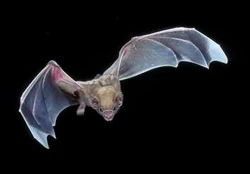| White-winged Vampire Bat | |
|---|---|
 | |
| Information | |
| Range | Mexico to southern Argentina and is present on the islands of Trinidad and Margarita. |
| Scientific Classification | |
| Kingdom | Animalia |
| Phylum | Chordata |
| Class | Mammalia |
| Order | Chiroptera |
| Family | Phyllostomidae Desmodontinae |
| Genus | Diaemus |
| Species | Diaemus youngi |
| Conservation Status | |
 Least Concern | |
The White-winged vampire bat (Diaemus youngi), is a species of vampire bat, is the only member of the genus Diaemus. It is found from Mexico to southern Argentina and is present on the islands of Trinidad and Margarita. In Trinidad, up to 30 Diaemus bats were found in a hollow immortelle tree and one was found in a well-lit cave, along with the common vampire bat (Desmodus rotundus) and greater sac-winged bat (Saccopteryx bilineata). Flying individuals are easily identified by their white wingtips.
They seem to prefer the blood of birds to that of mammals, and usually feed by hanging on the underside of a branch. Not surprisingly, they do not perform the flight-initiating jumps that characterize the common vampire bats. Though not as agile on the ground as the common vampire bat, they are quite proficient at climbing branches. White-winged vampires are much more docile around humans than common vampire bats and are also extremely vocal in the audible range.
They have two large oral glands: ". . . which can only be seen when the bat's mouth is opened and the glands brought forward like two small cannons. With open mouth, the bat will suddenly make an explosive, hissing sound followed by a foul smelling odour which seems to come from these glands. The use of the glands is not known."
"The bat opens its mouth when disturbed, bringing to the corners of its mouth two cup-shaped glands, each 2 to 3 mm in diameter, nearly filling the mouth. When necessary the glands can be directed forward, and with a noisy "psst" may emit a fine jet of liquid which has a powerful mustelid, skunk-like odor offensive to many people. Extractions tests made in Trinidad indicated the presence of several common amino acids and an unidentified sulphur-containing compound."
This bat carries disease, including rabies in Trinidad.
